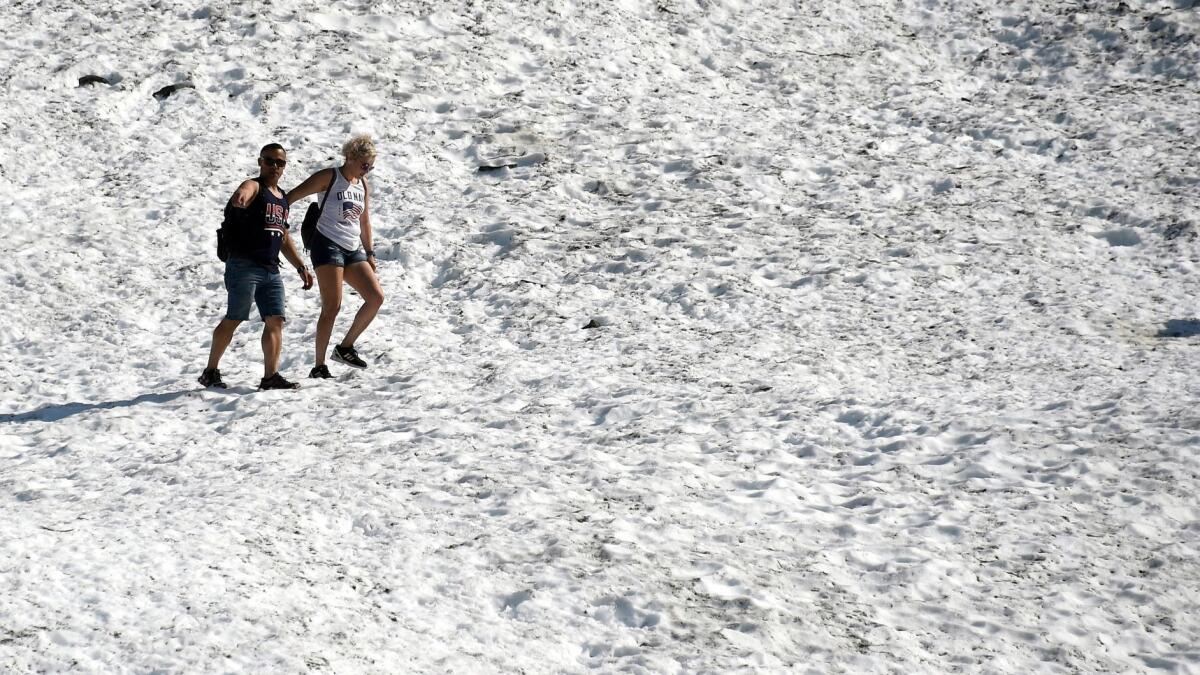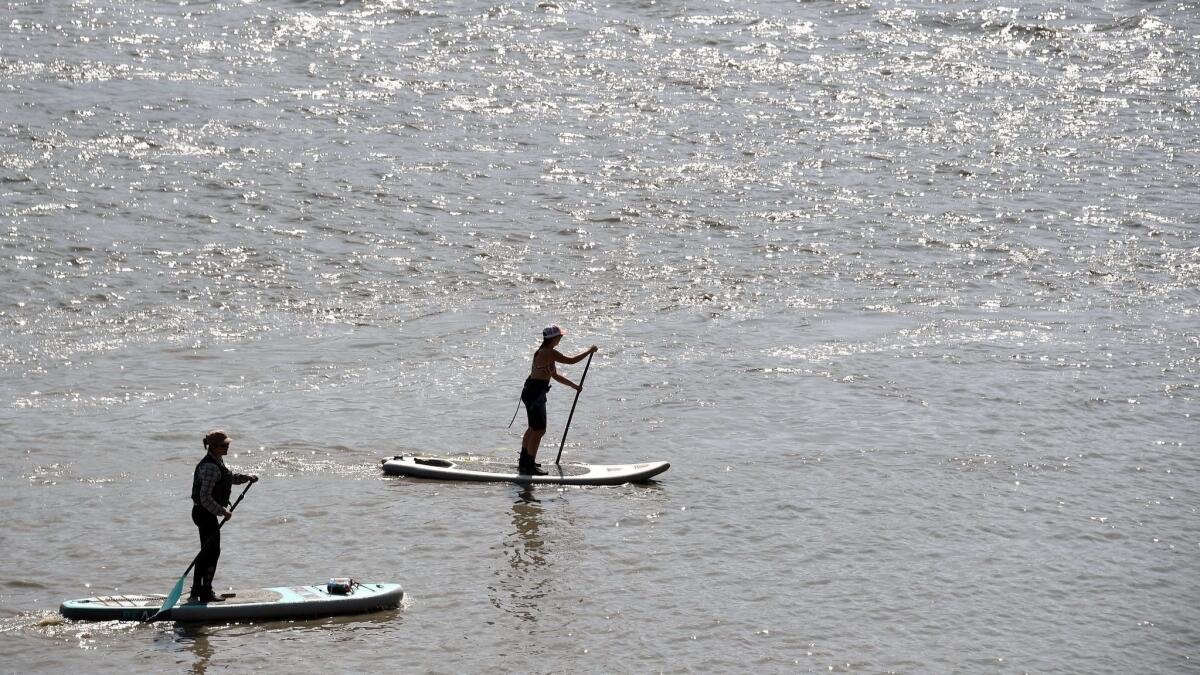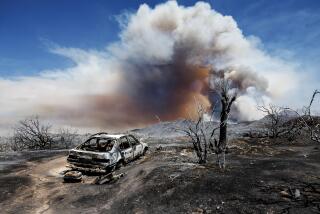Baked Alaska: It’s beach time as a heat wave hits cities across the state

- Share via
Reporting from Anchorage — Bears and moose are seeking relief in garden sprinklers. Stores are out of ice. Kids are lamenting the cancellation of Independence Day fireworks — not that pyrotechnics show up all that well anyway under the midnight sun.
Anchorage, and much of Alaska, is shattering temperature records amid a heat wave accompanied by wildfires that have blanketed the city in smoke. The state’s largest city hit the 90-degree mark on Thursday, breaking a record of 85 degrees set half a century ago. Forecasters expect temperatures to linger in the 80s into the coming week.
Such conditions would hardly cause anyone to break a sweat in either the Lower 48 or Hawaii. But Alaskans don’t normally get baked. Anchorage usually hits 70 only a dozen times a summer — and rarely reaches 80.
Val Miraglia, 68, and her husband, Rob Lang, 67, were hiking in blazing sunshine in hills overlooking downtown Anchorage on Thursday — but stopped after a brown bear ran across the trail. Miraglia said that black bears and moose have been cooling off in their backyard sprinkler.
Another Anchorage resident, Kathleen Wilson, quipped that Alaska seemed to be turning into Arizona. “People who don’t realize what’s happening with global warming just need to come see it here,” she said.
High temperatures feel hotter in Alaska than at lower latitudes, climate scientists say. Because it’s lower in the sky, the sun’s rays hit a larger portion of a person’s full torso, heating up more of the body.
This year in Anchorage, the average temperature in June exceeded 60 degrees, breaking the previous record of 59.5 degrees set in 2015. The city broke five daily high-temperature records in June, making many residents begin to consider looking into air conditioning.
“These kind of extreme events become much more likely in the warming world that we live in,” said Rick Thoman, a climatologist at the University of Alaska Fairbanks. Other extremes this year, he said, have included an early snow melt, above normal sea-surface temperatures and record low ice in the Chukchi and Beaufort seas.
Extremely dry conditions led to cancellation of all Fourth of July fireworks shows in the Anchorage area. Smoke caused officials to call off the children and teen competition in the annual Mount Marathon Race in Seward, 125 miles south.
More than 89,000 acres in the Kenai National Wildlife Refuge, on a peninsula southwest of Anchorage, have been consumed by the Swan Lake fire, which was caused by lightning and is producing the heavy smoke. More than 100 wildfires are burning across Alaska, prompting evacuation orders and air-quality alerts.
Cities across the state broke temperature records Thursday, with Kenai and King Salmon both hitting 89 degrees. Palmer measured in at 88 degrees, tying its 2011 all-time high.
In her Anchorage garden bursting with 138 varieties of dahlias, Marya Morrow, 75, showed visitors flowers and vegetables that regularly win prizes at the Alaska State Fair. “We’ve gone from looking for places in the sun to garden to looking for places in the shade,” she said.
Normally by July 4, three dozen varieties of dahlias are blooming in Morrow’s garden. But now about 60 types are flowering, she said.
Jeff Lowenfels has monitored Alaska’s warming trend during decades as a gardening columnist for the Anchorage Daily News. When he started the column 44 years ago, the area’s growing season was 120 days. It’s increased to as much as 145 days, he said.
The longer season is great for tomatoes, but warmer temperatures have brought ticks and garter snakes to southeast Alaska, Lowenfels said. Walking over to a lilac bush in his garden, he pointed out leaves discolored by a caterpillar that has infested the plant species across Anchorage, abetted by dry conditions.
Lowenfels pointed out a daylily, an orange-flowering plant transplanted years ago from his late grandfather’s garden in New York state. “Normally they don’t bloom here” because it’s too cold, he said. “But that is a bud.”
Invasives reaching Alaska include the Mayday tree, which is beginning to overtake riverbanks that salmon need for habitat, Lowenfels said.
From his house, Lowenfels has a sweeping view across the Turnagain Arm tidal waterway to the Kenai Mountains. Geese and shore birds used to populate the tidal flats, he said, but glacial melting has spread mud across the area, smothering the grasses that they fed on.
Evidence of climate change gives rise to sardonic humor in Anchorage, which tends to be more liberal politically than other areas of the state. “We didn’t have these warm temperatures under Obama,” said Fred Dewey, a retired attorney.
“Alaska may become one of the most comfortable places to live in the next 50 to 100 years if this continues,” said Ed Godnig, a Wasilla optometrist.


More to Read
Sign up for Essential California
The most important California stories and recommendations in your inbox every morning.
You may occasionally receive promotional content from the Los Angeles Times.











